TBSE Tripura Class 12 Biology Suggestion 2024
Reproduction in Organisms
- Variation : Since fusion of gametes from different parents occur during sexual reproduction, hence genetic recombination takes place causing variations.
- Evolution : Variation being a major factor of natural selection, therefore, it plays an important role in evolution.
- Adaptation : The offspring produced due to sexual reproduction adapt better to the changing environmental conditions.
- Vigour and Vitality : Genetic recombination, interaction, etc. during sexual reproduction provide vigour and vitality to the offspring.
This statement is always true. The offspring produced due to sexual reproduction adapt better to the changing environmental conditions. Genetic recombination, interaction, etc. during sexual reproduction provide vigour and vitality to the offspring.

Modified tuberous roots of sweet potato, tapioca, yam, Dahlia and Tinospora can be propagated vegetatively when planted in soil. Small plants emerging from the buds (called eyes) of the potato tuber, from the rhizomes of banana and ginger are other examples.
The zygote is always diploid and formed by the fusion of gametes. It is usually non- flagellated and non-motile or motile. It is the net result of sexual reproduction.
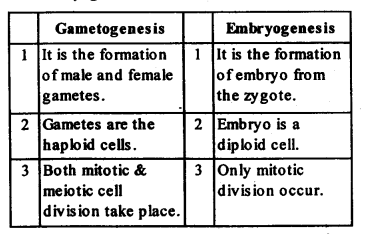
Sexual Reproduction in Flowering Plants

3. Arrange the following terms in the correct development sequence: Pollen grain, sporogenous tissue, microspore tetrad, pollen mother cell, male gametes.
Ans: The correct developmental sequence for the formation of male gametes is :
Sporogenous tissue —» Pollen mother cell —» Microspore tetrad —» Pollen grain —» Male gametes.
4. With a neat, labelled diagram, describe the parts of a typical angiosperm ovule.
Ans:
5. What is meant by monosporic development of female gametophyte?
Ans: In majority of flowering plants one of the megaspores is functional while the other three degenerate. Only the functional megaspore develops into the female gametophyte or embryo sac. This method of development of embryo sac from a single megaspore is called monosporic development.
6. With a neat diagram explain the 7-celled, 8- nucleate nature of the female gametophyte.
Ans:
7. What are chasmogamous flowers? Can cross-pollination occur in deistogamous flowers? Give reasons for your answer.
Ans: Chasmogamous flowers are those flowers which are open with exposed anther and stigma.
Cleistogamous flowers are those flowers which do not open at all. In these flowers, the anthers and stigma lie close to each other, when anthers dehisce in the flower buds, the pollen grains come in the contact with stigma to effect pollination. So these flowers are invariably self-pollinated as the flowers remain closed and there is no chance of cross pollen landing on the stigma. Pollination and seed setting are assured even in the absence of pollinators
8. Mention two strategies evolved to prevent self-pollination in flowers.
Ans: Continued self-pollination decreases the vigour and vitality of a particular race. Thus, flowering plants have developed many devices to discourage self-pollination and to encourage cross-pollination.
Dichogamy and self-sterility are.two most common devices that ensure cross-pollination. Dichogamy – Maturation of anther and stigma at different times in a bisexual flower prevent self-pollination.
Self-sterility (or self-incompatibility) – Due to the presence of self-sterile gene in some flowers, pollen grains do not germinate on the stigma of that flowers. e.g.,- tobacco, potato.
10. What is bagging technique? How is it useful in a plant breeding programme?
Ans: It is the covering of emasculated flowers (removal of anthers in bud condition from a bisexual flower by a bag of butter paper or polythene in their bud condition i.e., before anthesis) to prevent contamination of its stigmas with unwanted pollens. When the stigmas of emasculated flowers mature the bags are removed, stigmas are dusted with pollen grains of desired male . plants by means of a presterilized brush and flowers are rebagged till fruit develop. This technique is mainly used in artificial hybridization. Plant breeders often use this technique to prevent the contamination of stigma of the flowers from unwanted pollen grains.
13. Differentiate between:
(a)hy pocotyl and epicotyl;
(b)coleoptile and coleorrhiza;
(c)integument and testa;
(d)perisperm and pericarp.
Ans:

- Qallase enzyme : Tapetum secretes callase enzyme which dissolves callose substances by which four pollens of a pollen tetrad are united, hence separating microspores or pollens of a tetrad.
- Ubisch bodies : These bodies of lipid nature are also secreted by tapetum. Ubisch bodies get covered with sporopollenin and thus increase thickness of exine (i.e., outer layer of pollen wall). Ubisch bodies are spheroidal and have diameter of only few microns. These are produced only by glandular tapetum (not by amoeboid tapetum).
- Pollen kit substances : Tapetum also secretes pollen kit, outer most oily, thick, viscous, sticky, electron dense homogeneous coating of pollen grains of many entomophilous plants.
Human Reproduction
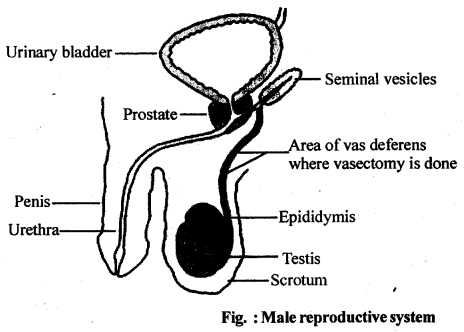


The ovaries have two major functions. One is the production of eggs or ova, and the second is the production of hormones or chemicals which regulate menstruation and other aspects of health and well-being, including sexual well-being. Estrogen and progesterone are the most important hormones which serve many functions like, they induce and maintain the physical changes during puberty and the secondary sex characteristics and they support maturation of the uterine endometrium in preparation for implantation for a fertilised egg, etc.

Spermatogenesis starts at the age of puberty due to significant increase in the secretion of gonadotropin releasing hormone (GnRH). The increased levels of GnRH then acts at the anterior pituitary gland and stimulates secretion of two gonadotropins – luteinising hormone (LH) and follicle stimulating hormone (FSH). LH acts at the Leydig cells and stimulates synthesis and secretion of androgens. Androgens, in turn, stimulate the process of spermatogenesis. FSH acts on the Sertoli cells and stimulates secretion of some factors which help in the process of spermiogenesis.


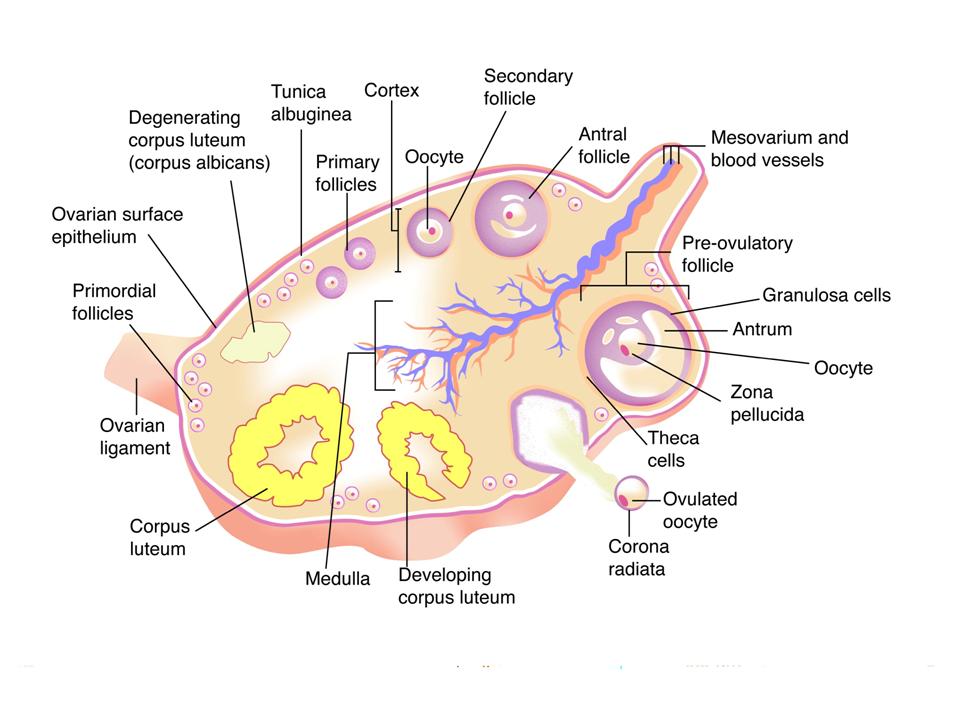
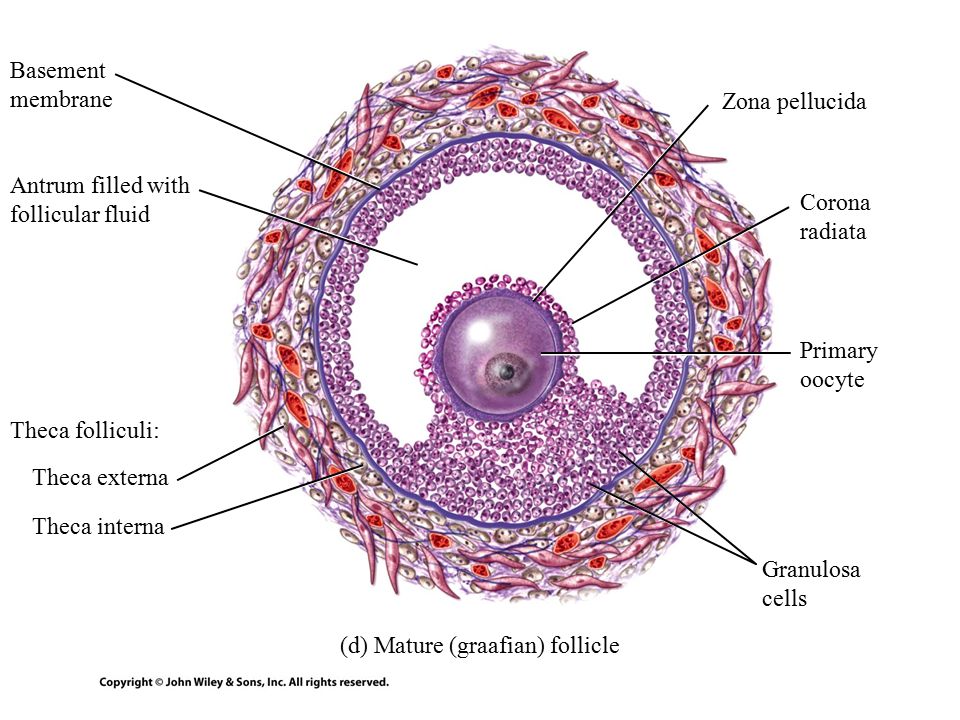
The process of parturition is induced by a complex neuroendocrine mechanisms involving cortisol, estrogen and oxytocin.
Reproductive Health
- Introduction of sex education in schools to give right information to the young minds about reproductive organs, accessory organs of reproduction, secondary sexual characters, adolescence and related changes, safe and hygienic sexual practices, STDs etc.
- Providing knowledge about available birth control methods, care of pregnant mothers, post-natal care of the mother and child, importance of breast feeding etc.
- Creating awareness about consequences of uncontrolled population growth and social evils (sex abuses and sex-related crimes, use of drugs, tobacco and alcohol etc.) among young people.
Ans: ART (Assisted Reproductive Technologies) is a term that describes several different methods used to help infertile couples. ART involves removing eggs from a woman’s body, mixing them with sperm in the laboratory and putting the embryos bath into a woman’s body.
Success rates vary depending on many factors.Something that affects the success rate of ART includes age of the partners, reason for infertility,type of ART, if the egg is fresh or frozen. Various methods are now available to help such couples are — in vitro fertilization, gamete intra fallopian transfer, intracytoplasmic sperm injection & artificial insemination.
(i) In vitro fertilization – Patient’s egg & her partner’s sperm are collected & mixed together in a laboratory to achieve fertilization outside the body. The embryo produced may then be transferred into the female patient. It is commonly knownas test tube baby programme.
(ii) Gamete Intra Fallopian Transfer (GIFT) – A procedure in which eggs are retrieved from a woman, mixed with sperm & immediately replaced in one or other of the women’s fallopian tubes so that they fertilize inside the body (invivo).
(iii) Intra Cytoplasmic Sperm Injection (ICSI)– In this method, sperm & eggs are retrieved from both the parents. A single sperm is injected directly into an egg, then the fertilized egg is implanted into the woman’s uterus.
(iv)Artificial insemination – In this technique, the semen is collected either from husband or a healthy donor & is artificially introduced either into the vagina or into the uterus of the female (IUI-Intra uterine insemination).
11. State True/False with explanation
(a) Abortions could happen spontaneously too. (True/False)
(b) Infertility is defined as the inability to produce a viable offspring and is always due to abnormalities/defects in the female partner. (True/False)
(c) Complete lactation could help as a natural method of contraception. (True/False)
(d) Creating awareness about sex related aspects is an effective method to improve reproductive health of the people. (True/False)
''
Principles of Inheritance and Variation
1.Mention the advantages of selecting pea plant for experiment by Mendel
Ans: Mendel select garden pea (Pisum Sativum) for the following reasons.
(i) It is an annual plant with short life span and gives results within 3 months.
(ii) The plant is grown easily and does not require after care except at the time of pollination.
(iii) F1 hybrids are fertile.
(iv) Seven pairs of contrasting characters easily detectable.
(v) True breeding self pollination.
2. Differentiate between the following –
(a) Dominance and Recessive
(b) Homozygous and Heterozygous
(c) Monohybrid and Dihybrid.
Ans: (a)The difference between dominance and recessive me:
(b) Differences between homozygous and heterozygous individuals :
(c) In breeding experiments when a cross is made between the individuals considering their same single character, it is called mono¬hybrid cross, while a cross is done consid¬ering two characters at fee same time is called dihybrid cross (Yellow Round * Green Wrinkled).
3. A diploid organism is heterozygous for 4 loci, how many types of gametes can be produced?
Ans: For a diploid organism, which is heterozygous for 4 loci, then 24 i.e. 2 x 2 x 2 x 2 = 16 types of gametes can be produced if the genes are not linked because for each heterozygous pair of genes there are two possibilities. So, for 4 pair the number of combination will be 16 gametes.
4. Explain the Law of Dominance using a monohybrid cross.
Ans: When two different factors (genes) or a pair of contrasting forms of a character are present in an organism, only one expresses itself in the F, generation and is termed as dominant while the other remains unexpressed and called recessive factors (gene).
A tall (TT) true breeding plant is crossed with a dwarf (tt) plant. The character of height is represented by‘T’ for tall‘t’ for dwarf are the alternate form as character of height. The Fj hybrid ‘Tt’ is Tall, showing that tall is dominant over dwarf while dwarf remains unexpressed in F, offspring due to phenomenon of dominance by tall factor or gene.In this Tt heterozygous has tall phenotype showing T is dominant over t allele.
5. Define and design a test-cross.
Ans: When an individual is crossed with the homozygous recessive parent. It is called test cross.
Test cross helps in establishing hetero/ homozygosity of dominant trait.
6. Using a Punnett Square, workout the distribution of phenotypic features in the first filial generation after a cross between a homozygous female and a heterozygous male for single locus.
Ans: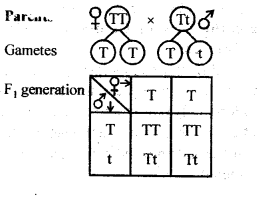
Phenotype: All tall
Genotype ratio : TT: Tt 2:2 or 1:1
7. When a cross is made between tall plant with yellow seeds (TtYy) and tall plant with green seed (Ttyy), what proportions of phenotype in the offspring could be expected to be
(a)tali and green.
(b)dwarf and green.
Ans: A cross between tall plant with yellow seeds (TtYy) & tall plant with green seed (Ttyy) is given below.
8. Two heterozygous parents are crossed. If the two loci are linked what would be the distribution of phenotypic features in F1 generation for a dihybrid cross?
Ans: Consider 2 characters Blue (B), long (L) seeds of a plant – both characters linked.
9. Briefly mention the contribution of T.H. Morgan in genetics.
Ans: Thomas Hunt Morgan (1866-1945), an American geneticist and Nobel Prize winner of 1933, is considered as “Father of experimental genetics” for his work on and discovery of linkage, crossing over, sex linkage, criss cross inheritance, linkage maps, mutability of genes, etc. He is called fly man of genetics because of selecting fruit fly (Drosophila melanogaster) as research, material in experimental genetics. It was largely due to his book, “The Theory of Gene”, that genetics was accepted as a distinct branch of biology. In 1910, he discovered linkage and distinguished linked and unlinked genes. Morgan and Castle (1911) proposed “Chromosome Theory of Linkage” showing that genes are located on the chromosomes and arranged in linear order. Morgan and Sturtevant (1911) found that frequency of crossing over (recombination) between two linked genes is directly proportional to the distance between the two. 1% recombination is considered to be equal to 1 centi Morgan (cM) or 1 map unit. He worked on sex linked inheritance and reported a white eyed male Drosophila in a population of red eyed and proved that gene of eye colour is located on X-chromosome. The male passed its genes on X-chromosomes to the daughter while the son gets genes on X-chromosome from the female (mother): It is called criss-cross inheritance.
10. What is pedigree analysis? Suggest how such an analysis, can be useful.
Ans: Pedigree analysis is study of pedigree for the transmission of particular trait and finding the possibility of absence or presence of that trait in homozygous or heterozygous state in a particular individual. Pedigree analysis helps-
(i) in analysis of transmission of character in family over generation.
(ii) in genetic counselling of disease like haemophilia.
(iii) to identify whether a particular genetic disease is due to recessive gene or a dominant gene.
(iv) to identify the possible origin of the defective gene in the family or in a population.
11. How is sex determined in human beings?
Ans: Sex determination refers to the mechanisms employed by organisms to produce offsprings that are of two different sexes. The sex of an individual is determined by the genetic information present in the individual’s sex chromosomes. Sex determination in human is done by XY type chromosome. In humans, females have two XX chromosomes and males have two different chromosomes (XY).
12. A child has blood group O. If the father has blood group A and mother of blood group B, work out the genotypes of the parents and the possible genotypes of the other off springs.
Ans:
13. Explain the following terms with example
(a) Co-dominance
(b) Incomplete dominance
Ans: (a) Codominance : Codominance is the phenomenon of two contrasting alleles of the same gene lacking dominant recessive ratio and expressing themselves simultaneously when present together. E.g. ABO blood group system – Human blood group AB is formed when alleles of blood groups A and B are present together (IAIB). Such RBCs carry both antigen A & B showing that both die alleles are expressing their effect phenotypically & codominant.
(b) Incomplete dominance : Incomplete dominance may be defined as the partial /expression of both alleles in a heterozygote so that the phenotype is intermediate between those of two homozygotes. In this none of the allele is completely dominant, e.g., Pink colour flower in dog flower. In Mirabilis jalapa & Snapdragon or dog flowers, there are two types of flower colour in pure state-red & white. When the two types of plant are crossed, the hybrid or plants of Fj generation have pink flowers. The pink colour apparently appears either due to mixing of red & white colours (incomplete dominance) or expression of a single gene for pigmented flower which produces only pink colour.
14. What is point mutation? Give one example.
Ans: Mutations arising due to change in single base pair of DNA is called point mutation. Eg., sickle cell anaemia, haemophilia.
15. Who had proposed the chromosomal theory of the inheritance?
Ans: Chromosomal theory of inheritance was proposed by Sutton and Boveri independently in 1902. The two workers found a close similarity between the transmission of Mendelian hereditary factors (genes) and behaviour of chromosomes during gamete formation and fertilisation. They proposed that chromosomes were the carriers of the Mendelian factors. It is the chromosome and not genes which segregate and assort independently during meiosis and recombine at the time of fertilisation in the zygote. Chromosomal theory of inheritance was expanded by Morgan, Sturtevant and Bridges.
16. Mention any two autosomal genetic disorders with their symptoms.
Ans: Sickle cell anaemia : Haemoglobin has less 02 transport, sickle shaped RBCs etc.
Phenylketonuria : Mental retardation (due to accumulation of phenylalanine in brain), hypopigmentation of skin & hair, eczema etc.
Molecular Basis of Inheritance
1. Group the following as nitrogenous bases and nucleosides: Adenine, Cytidine, Thymine, Guanosine, Uracil and Cytosine.
Ans: Nitrogenous Bases – Adenine, Uracil and Cytosine, Thymine; Nucleosides – Cytidine, guanosine.
2. If a double stranded DNA has 20 per cent of cytosine, calculate the per cent of adenine in the DNA.
Ans: In a DNA molecule, the number of cytosine molecule is equal to guanine molecules & the number of adenine molecules are equal to thymine molecules. As a result, if a double stranded DNA has 20% of cytosine, it has 20% of guanine. The remaining 60% includes both adenine & thymine which are in equal amounts. So, the percentage of adenine is 30%.
3. If the sequence of one strand of DNA is written as follows:
5′ – ATGCATGCATGCATGCATGCATGCATGC – 3′
Write down the sequence of complementary strand in 5′ —> 3′ direction.
Ans: If the sequence of one strand of DNA is written as follows:
5′ – ATGCATGCATGCATGCATGCATGCATGC – 3′
The sequence of the complementary strand in 5′ —> 3′ direction will be:
5′ – GCATGCATGCATGCATGCATGCATGCAT – 3′
4. If the sequence of the coding strand in a transcription unit is written as follows: 5-ATGCATGCATGCATGCATGCA TGCATGC-3′
Write down the sequence of mRNA.
Ans: mRNA: 5′ -A U G CAU G CAU G C AU G CA UGCAUGCAUGC-3′.
5. Which property of DNA double helix led Watson and Crick to hypothesise semi-conservative mode of DNA replication? Explain
Ans: The antiparallel, double-stranded nature of the DNA molecule led Watson and Crick to hypothesise semi-conservative mode of DNA replication. They suggested that the two strands of DNA molecule uncoil and separate, and each strand serves as a template for the synthesis of a new (complementary) strand alongside it. The template and its complement, then form a new DNA double strand, identical to the original DNA molecule. The sequence of bases which should be present in the new strands can be easily predicted because these would be complementary to the bases present in the old strands. A will pair with T, T with A, C with G, and G with C. Thus, two daughter DNA molecules identical to the parent molecule are formed and each daughter DNA molecule consists of one old (parent) strand and one new strand. Since only one parent strand is conserved in each daughter molecule, this mode of replication is said to be semiconservative. Meselson and Stahl and Joseph Taylor, later proved it by experiments.
6. Depending upon the chemical nature of the template (DNA or RNA) and the nature of nucleic acids synthesized from it (DNA or RNA), list the types of nucleic acid polymerases.
Ans: (i) DNA dependent DNA polymerase – synthesis.
(ii) DNA dependent RNA polymerase – synthesis.
(iii) RNA dependent DNA polymerase – Retroviral nucleic acid.
(iv) RNA dependent RNA polymerase – cDNA synthesis.
7. How did Hershey and Chase differentiate between DNA and protein in their experiment white proving that DNA is the genetic material?
Ans: Alfred Hershey and Martha Chase (1952) worked with viruses that infect bacteria called bacteriophages. In 1952, they chose a bacteriophage known as T2 for their experimental material.
They grew some viruses on a medium that contained radioactive phosphorus (p32) and some others on medium that contained radioactive sulphur (s35). Viruses grown in the presence of radioactive phosphorus contained radioactive DNA but not radioactive protein because DNA contains phosphorus but protem does not. Similarly, viruses grown on radioactive sulphur contained radioactive protein but not radio’active DNA because DNA does not contain sulphur.
Radioactive phages were allowed to attach to E. coli bacteria. Then, as the infection proceeded, the viral coats were removed from the bacteria by agitating them in a blender. The virus particles were separated from the bacteria by spinning them in a centrifuge. ,
Bacteria which was infected with viruses that had radioactive DNA were radioactive, indicating that DNA was the material that passed from the virus to the bacteria. Bacteria that were infected with viruses that had radioactive proteins were not radioactive. This indicates that proteins did not enter the bacteria from the viruses. DNA is therefore the genetic material that is passed from virus to bacteria.
8. Differentiate between the followings:
(a) Repetitive DNA and Satellite DNA
(b) mRNAand tRNA
(c) Template strand and Coding strand
Ans: (a) The main differences between repetitive DNA and satellite DNA are as following:
(b) The main difference between mRNA and tRNA are as following:
(c) The main difference between template strand and coding strand are as follows :
9. List two essential roles of ribosome during translation.
Ans: Two essential roles of ribiosomes during translation are ;o
(i) they provide surface for binding of mRNA in the groove of smaller sub unit of ribosome.
(ii) As larger sub unit of ribosome has peptidy transferase on its ‘P’ site, therefore, it helps in joining amino acids by forming peptide bonds. .
10. In the medium where E. coli was growing, lactose was added, which induced the lac operon. Then why does lac operon shut down some time after addition of lactose in the medium?
Ans: Lac operon is switched on, on adding lactose in medium, as lactose acts as inducer and makes repressor inactive by binding with it. When the lac operon system is switched on, β-galactosidase is formed, which converts lactose into glucose and galactose. As soon as all the lactose is consumed, repressor again becomes active and causes the system to switch off (shut down).
11. Explain (in one or two lines) the function of the followings:
(a) Promoter
(b) tRNA
(c) Exons
Ans: Promoter: It is one of the three components of a transcription unit that takes part in transcription. It is located at the start 5′ end and provides site for attachment of transcription factors (TATA Box) and RNA polymerase. tRNA: It takes part in the transfer of activated amino acids from cellular pool to ribosome for their taking part in protein formation.
Exons: In eukarytoes, DNA is mosaic of exons and introns. Exons are coding sequences of DNA which are transcribed and translated both.
12. Why is the Human genome project called a mega project?
Ans: Human genome project is called a mega project because
(i) it required bioinformatics data basing and other high speed computational devices for analysis, storage and retrieval of information.
(ii) it generated lot of information in the form of sequence annotation.
(iii) it was carried out in number of labs and coordinated on extensive scale.
13. What is DNA fingerprinting? Mention its application.
Ans: DNA fingerprinting or DNA typing is a technique of determining nucleotide sequences of certain areas (VNTRs) of DNA which are unique to each individual. Each person has a unique DNA fingerprint. Unlike a conventional fingerprint that occurs only on the fingertips and can be altered by surgery, a DNA fingerprint is the same for every cell, tissue and organ of a person. It cannot be changed by any known treatment. Applications of DNA fingerprinting are as follows:
- Paternity disputes can be solved by DNA fingerprinting.
- DNA fingerprinting technique is being used to identify genes connected with hereditary diseases.
- It is useful in detection of crime and legal pursuits.
- It can identify racial groups, their origin, historical migrations and invasions.
14. Briefly describe the following:
(a) Transcription
(b) Polymorphism
(c) Translation
(d) Bioinformatics
Ans: Transcription : It is DNA directed synthesis of RNA in which the RNA is transcribed on 3*—>5’ template strand of DNA in 5’—>3’ direction. Polymorphism: Variation at genetic level arisen due,to mutation, is called polymorphism. Such variations are unique at particular site of DNA, forming satellite DNA. The polymorphism in DNA sequences is the basis of genetic mapping and DNA finger printing.
Translation : Protein synthesis from mRNA, tRNA, rRNA.
Bioinformatics : Computational method of handling and analyzing biological databases.
Evolution
Evolution Chapter Class 12 NCERT Q1. Explain antibiotic, resistance observed in bacteria in light of Darwinian selection theory.
Ans: According to Darwin, environment selects organisms with favourable variations and these organisms are allowed to survive. When a bacterial population encounters a particular antibiotic, those sensitive to it die. But some bacteria having mutations become resistant to the antibiotic. Such resistant bacteria survive and multiply quickly as the competing bacteria have died. Some the resistance providing genes become widespread and entire bacterial population becomes resistant.
Evolution Class 12 NCERT Solutions Q2. Find out from newspapers and popular science articles any new fossil discoveries or controversies about evolution
Ans: New fossil discoveries are as follows :
1. An international research team has recently discovered some amber fly specimens in El Sopalo cave (Cantabria, Spain). According to an article published in the scientific journal ‘Current Biology’, these specimens fed on nector and pollinated gymnosperm plants 105 million years ago.
2. Research conducted in Japan has revealed a very unusual new species of octocoral from a shallow coral reef in Okinawa, Japan. This new species can be considered as “living fossil,” and is related in many ways to the unusual blue coral.
3. The 48 million year old fossil, recovered from the Bridger Formation in Wyoming, is the first description of a new species, named Babibasiliscusalxiby the author, and
may represent the earliest clear member of the lizard group, Corytophanidae.
4. Neanderthals became extinct about 40,000 years ago but contributed on average one to three percent to the genomes of present day Eurasians. Researchers have now analysed DNA from a 37,000 to 42,000 year old human mandible in Romania and have found that six to nine percent of this person’s genome came from Neanderthals, more than any other human sequenced till date. Because large segments of this individual’s chromosomes are of Neanderthal origin, a Neanderthal was among his ancestors as recently as four to six generations back in his family tree. This shows that some of the first modern humans that came to Europe mixed with the local Neanderthals.
Chapter 7 Biology Class 12 NCERT Solutions Q3. Attempt giving a clear definition of the term species.
Ans: Species is population or group of individuals that have potential of interbreeding and are able to produce viable, fertile young ones but are reproductively isolated from members of other species.
Evolution NCERT Solutions Q4. Try to trace the various components of human evolution (hint: brain size and function, skeletal structure, dietary preference, etc.)
Ans:
Dietary preference:
Dryopithecus and Ramapithecus — herbivores Australopithecus Africans, Homo Carnivores habilis
Homo erectus, Homo sapinens — Omnivores
Evolution NCERT Solutions Class 12 Q5. Find out through internet and popular science articles whether animals other than man has self-consciousness.
Ans: Recent studies on self consciousness says gibbons are the nearest to human in this respect. Apes and orangutans came next. Among domestic animals, dog and other members of canidae family show subtle self consciousness.
Evolution NCERT Q6.List 10 modern-day animals and using the” internet resources link it to a corresponding ancient fossil. Name both. ANC
Ans: (i) Cockroach, Limulus (king crab), Neopilina, Latimaria (Fish) are fossil that has remain unchanged over years.
(ii) ‘Trilobites- fossil arthropods
(iii) Lung fishes – connecting link between fishes and amphibians
(iv) Peripatus – connecting link between annelids and arthropods .
(v) Woody mammoth – ice fossils
(vi) Gastropods – mould and cast fossil
(vii) Giant elk – amber fossil of asphalt
(viii) Dinosaur footprint – imprints
NCERT Solutions of Evolution Class 12 Q7. Practise drawing various animals and plants.
Ans: (1) Elephant
(2) Camel
(3) Dog
(4) Rose
(5) Dahlia
(6) hibiscus
Class 12 Biology Chapter 7 NCERT Solutions Q8.Describe one example of adaptive radiation.
Ans: Darwin’s finches of the Galapagos islands had common ancestors but now have different types of modified beaks according to their food habits.
Evolution Questions And Answers Class 12 Q9. Can we call human evolution as adaptive radiation?
Ans: Yes, human evolution is an example of adaptive radiation as different species of human evolved across different areas of world as they diverged to different areas in following fashion.
(i) Hominid introduction occured in Africa and Asia:
(ii) Homo habilis lived in Africa – 2 million years ago.
(iii) Homo erectus- migrated to Asia and Europe and diverged into 2 species – Java Man and Peking Man.
(iv) Similarly Homo erectus – was followed by Homo sapiens.
(v) Primitive neanderthal man in Europe gave way to African cromagnon.
Evolution Class 12 NCERT Q10. Using various resources such as your school library or the internet and discussions with your teacher, trace the evolutionary stages of any one animal say horse.
Ans: Evolutionary stages of horse:
Eohippus – Mesohippus – Merychippus – Pliohippus – Equus.
Evolutionary trend:
(i) Increase in body size.
(ii) Elongation of neck.
(iii) Lengthening of limbs.
(iv) Enlargement of third digit.
(v) Increase in structural complexity of teeth for feeding on grass.












0 Comments